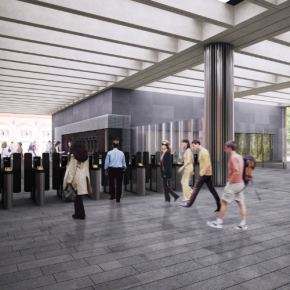
Wrightstyle talks railway fire safety
Wrightstyle‘s Marketing Director, Jane Embury, takes a look at railway station fire safety, sharing the company’s expertise in transportation projects.
Having supplied systems for transportation projects in Hong Kong, Dubai and the UK, and currently working on six Crossrail stations, the steel and aluminium glazing company understands the importance of railway station fire safety.
The final Crossrail element will be at Paddington station for which Wrightstyle are currently fabricating bonded doors and screens. Wrightstyle also supplied a range of fire-rated doors, screens and curtain walling to Bond Street, Farringdon, Liverpool Street, Whitechapel and Woolwich stations.
The line is expected to increase London’s rail capacity by 10% when it is fully operational – perhaps at the end of this year. The Elizabeth Line will have 40 stations, including ten new stations, with up to 24 trains running each hour in both directions on its 100km route.
The fire safety measures being installed on the Elizabeth Line are state-of-the-art, reflecting modern fire safety regulations and advances in building materials – including Wrightstyle’s own fire systems.
Jane explains: “Railway stations are mercifully rare – and that, more than anything, speaks volumes for how far fire safety has progressed over recent years.
“The last major railway station fire in the UK was at Nottingham in January last year, causing significant disruption and a repair bill of at least £2 million. It’s believed that the fire was started deliberately.
“Also last year, trains caught fire while at Plymouth and Grantham stations, similar incidents to others recently at London’s Victoria station and at Sevenoaks in Kent.
“In each incident, the station was evacuated, the fire contained, and nobody was hurt. But not all station fires have happy endings. The worst modern station fire disaster, in 2003, was at Daegu Station in South Korea in which 192 people died.
“Of particular concern was how badly the station’s fire compartmentation systems were designed. Instead of containing the fire, but allowing people to escape, the system closed fire shutters and smoke barriers – effectively concentrating the heat into places from which people were desperately trying to escape.
“It was a reminder of the King’s Cross disaster which fire claimed the lives of 31 people in 1987, and which was probably started by a discarded match or dropped cigarette on an escalator, underlining how most major accidental fires start from something almost insignificant.
“All Wrightstyle systems are tested as one compatible unit and, as we always emphasise to architects and designers, based on our extensive fire, ballistic and bomb testing experience, the glass and steel components should always be specified as one integrated and tested assembly.
“The glass will only be as good as its framing system, or vice versa, and if one fails, both fail, with potentially catastrophic consequences.”
Therefore, the importance of a good framing system should not be overlooked in the fire safety of transportation projects.
Wrightstyle,
Unit 2&7 Banda Trading Estate,
Nursteed Road,
Devizes,
United Kingdom,
SN10 3DY
Visit Supplier's page
Latest news

11th April 2025
Don’t Do a Dave! It’s Time to Lock FIT Show 2025 in Your Calendar!
It’s that time again – FIT Show is back! You could be forgiven for thinking there won’t be much new to see when FIT Show returns to the NEC from 29 April – 1 May. Wrong!
Posted in Articles, Building Industry Events, Building Industry News, Building Products & Structures, Building Services, Continuing Professional Development (CPD's), Exhibitions and Conferences, Information Technology, Innovations & New Products, Restoration & Refurbishment, Retrofit & Renovation, Seminars, Training
11th April 2025
Insight Data: Boost construction success with project and prospect data
For those working in construction – in whatever capacity – the last few years haven’t been much fun. And according to the latest statistics, it would seem the challenges are continuing – Alex Tremlett, Insight Data’s Commercial Director, has more…
Posted in Articles, Building Industry News, Building Services, Information Technology, news, Research & Materials Testing
11th April 2025
ASSA ABLOY EMEIA: Learn how to tackle the security challenges of digitalising access with insights from industry experts
In a new series of videos, experts in various specialisms within ASSA ABLOY share their expertise on digital access, including the complexities to overcome and the range of benefits for those who get digital access right…
Posted in Access Control & Door Entry Systems, Architectural Ironmongery, Articles, Building Industry News, Building Products & Structures, Building Services, Doors, Facility Management & Building Services, Information Technology, Innovations & New Products, Posts, Restoration & Refurbishment, Retrofit & Renovation, Security and Fire Protection, Videos
10th April 2025
Geberit completes 150 Acts of Kindness
Geberit has raised nearly £14,000 for various charities through its ‘150 Acts of Kindness’ initiative, a year-long programme of fundraising and volunteering to mark the company’s 150th anniversary in 2024.
Posted in Articles, Bathrooms & Toilets, Bathrooms, Bedrooms & Washrooms, Building Industry Events, Building Industry News, Building Products & Structures, Building Services, Charity work, Drainage, Interiors, Pipes, Pipes & Fittings, Plumbing, Restoration & Refurbishment, Retrofit & Renovation
 Sign up:
Sign up: